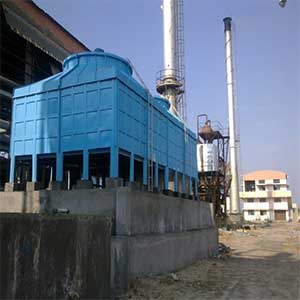FRP Box Type Cooling Towers :
A FRP Box type cooling tower is a cooling system which finds growing application both for inland and sea going ships. FRP Box type Cooling water is forced through a U-tube-bundle, which is placed in a sea-chest having inlet- and outlet-grids. The FRP Box type cooling tower effect is reached by natural circulation of the outboard water in the sea-chest or by a circulation due to the speed of the vessel. The outboard water is heated and rises by its lower density, thus causing a natural upward circulation.
Image:

Process:
FRP Box type Cooling towers vary in size from small roof-top units to very large hyperboloid structures (as in the adjacent image) that can be up to 200 meters tall and 100 meters in diameter, or rectangular structures that can be over 40 meters tall and 80 meters long. The FRP Box type cooling towers are often associated with nuclear power plants, although they are also used to some extent in some large chemical and other industrial plants. Although these large towers are very prominent, the vast majority of FRP box type cooling towers is much smaller, including many units installed on or near buildings to discharge heat from air conditioning.
Benefits:
- Higher efficiency
- Minimum drift loss of water
- No contamination, due to dust or foreign particles
- Piping cost negligible and suitable for small unit
- Good-looking appearance
- Low operating cost
- Lightweight and portable components
- Durable construction
- Simple and safe for maintenance.
Features:
- Single water inlet per cell: easier piping and no balancing per inlet needed. This is a major issue with cross flow type of towers were the condenser water is fed to two open hot water basins at the top, which need to be balanced with expensive valves to ensure proper distribution over both sides of the cooling tower.
- Easy access to the sloped basin for maintenance and operation makes this type the favourite of the users.
- The fill is completely encased in the unit casing and as such has a maximum of protection.
- No direct sunlight can come in contact with the water in circulation in the tower: this is an important feature which reduces the potential for algae growth and development in the cooling tower and thus reducing water treatment and maintenance costs. In cross flow type of cooling towers sunlight is in direct contact with the water at the air inlet sides and in the basin through the fan opening on the top.
- Sand and dust are in the plenum beneath the fill washed out of the water before the air enters the fill; in a cross flow type the air contaminated with sand and dust enters directly the fill at the air entry sides causing fast contamination and scale built up in the fill.
Advantages:
- Elimination of complete outboard secondary cooling water circuit on board. So there is no need for a cooling water pump, filters, valves, and pipelines etc. – parts that are sensitive for maintenance.
- equipped Research and Development department which ensures a design according to the latest developments and techniques.
- The box coolers are much less susceptible to corrosion and fouling compared with any other solution.
- Energy saving (secondary pump) – in a conventional cooling water system, the secondary pump of approximately 15 kW consumes approx. 3 liters fuel per hour. At a yearly operation level of 5000 hours this means a saving of 15000 liters.

